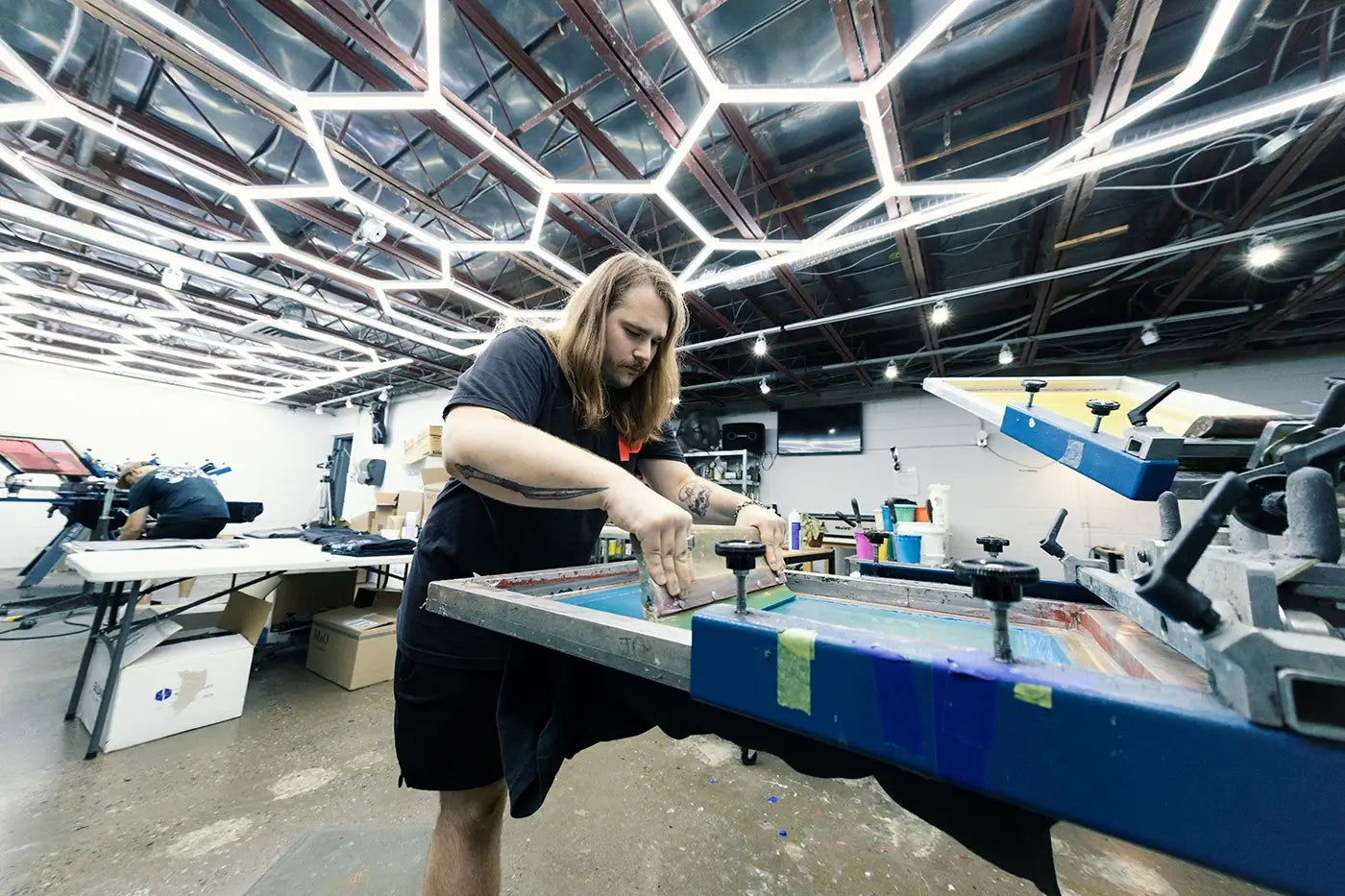High-Volume T-Shirt Printing for Schools and Organizations
High-Volume T-Shirt Printing for Schools and Organizations
Blog Article
Screen Printing Uncovered: Whatever You Required to Learn About T-Shirt and Garment Printing Techniques
If you've ever asked yourself how those dynamic designs end up on your favorite tee shirts, you remain in the appropriate area. Display printing is a remarkable method that incorporates art with strategy, providing endless opportunities for imagination. Understanding the basics, from tools to ink options, can substantially impact your results. Prepared to explore the necessary components that make screen printing an art form? Let's uncover the details that can raise your tasks.
The Basics of Screen Printing: Just How It Works
When you plunge right into screen printing, you'll discover it's both a science and an art. At its core, display printing includes developing a pattern, or display, that enables ink to travel through only in specific areas (screen printing kit). You start by picking your design and preparing your display with a light-sensitive solution. When you subject this emulsion to light, it solidifies, leaving your layout as an unfavorable space.
Following, you'll blend your inks and prepare your printing surface area. Setting the screen over the textile, after that use a squeegee to press ink with the display onto the garment. This process requires precision, as you want clear, vibrant prints. After printing, you'll treat the ink with warmth, ensuring it adheres to the fabric and lasts with washes. Each step is crucial, and mastering them will certainly elevate your display printing abilities, transforming easy garments right into distinct, meaningful pieces.
Kinds Of Screen Printing Strategies
When you comprehend the essentials of display printing, it's time to discover the different techniques that can boost your layouts. One preferred method is typical screen printing, where ink is pressed through a stenciled display. This technique is excellent for bold, vibrant shades. There's water-based ink printing, which offers a softer feel and is environmentally friendly, yet it requires a different approach to healing.
If you're aiming for fine information, take into consideration discharge printing. This method gets rid of dye from the material, leaving a soft, classic appearance. An additional option is plastisol printing, understood for its durability and vivid colors, making it a favorite for lots of brand names. Ultimately, try out halftone printing to develop gradient effects and detailed designs. Each strategy has its distinct appeal, so don't wait to attempt them out to locate what matches your design best!
Essential Equipment for Screen Printing
To attain magnificent results in display printing, having the ideal equipment is essential. You'll need a strong screen printing frame, which holds the mesh that transfers your design onto the garment. Next, spend in premium mops; these are necessary for applying ink equally throughout the display.
Picking the Right Inks and Products
When choosing inks and products for screen printing, you require to think about the sort of ink that works ideal for your job. Consider fabric compatibility to guarantee your designs look last and fantastic lengthy. Also, explore green ink alternatives to make your printing process extra sustainable.
Kinds Of Screen Inks
Choosing the right screen ink is vital for achieving lively, long lasting prints that meet your job's needs. There are numerous kinds of screen inks to analyze. Plastisol ink is prominent for its versatility and simplicity of use, supplying excellent color opacity on dark textiles. Water-based ink, on the other hand, offers a softer feel and is eco-friendly, making it ideal for those wanting to minimize their ecological impact. Release inks eliminate dye from the material, leading to a soft, vintage appearance but require particular handling. Specialized inks, such as metallic or glow-in-the-dark, can include unique effects to your layouts. Evaluate your task needs and select the ink that aligns ideal with your desired result.

Fabric Compatibility Considerations
Understanding textile compatibility is important for achieving top quality display prints, particularly since different materials react uniquely to various inks. Always examine your inks on sample material to guarantee they stick appropriately and keep shade integrity. In addition, keep in mind that fabric weight and structure can impact the last end result, so choosing the appropriate ink and material combo is vital for your job's success.
Eco-Friendly Ink Options
Environment-friendly inks are becoming a prominent selection for display printers who wish to lessen their environmental influence while maintaining quality. When selecting inks, consider water-based inks, which are much less hazardous and less complicated to tidy up contrasted to typical solvents. These inks bond well with fabrics, delivering vivid results without poisonous chemicals. You may additionally discover eco-solvent inks that utilize fewer volatile organic substances (VOCs), making them a much safer option for both your health and the world.
Additionally, look for inks made from renewable energies, such as soy or vegetable-based alternatives. Related Site By selecting the right inks and products, you'll not just develop spectacular styles however additionally add to a more sustainable printing procedure. Make the button, and your prints will show your dedication to the setting!
Preparing Your Design for Screen Printing

Submit Layout Demands
To guarantee your layout looks lively and sharp on fabric, you'll need to pay close attention to file style needs for screen printing. Make certain your style has a clear history to protect against undesirable white sides on your prints. Maintain color settings in mind; CMYK is basic for screen printing, so transform your RGB develops as necessary.
Color Separation Techniques
Color splitting up is an essential step in preparing your style for screen printing, and mastering it can greatly enhance your print quality. You'll require to break your layout right into specific colors, as each shade calls for a different screen throughout printing. Start by determining all the colors in your style and produce layers for each one. You can use software like Adobe Photoshop or Illustrator to separate and different shades efficiently. Be specific to save each layer as a separate documents, usually in a style like TIFF or PSD. This precision not only assures exact shade depiction however check my reference also streamlines the printing procedure. By paying attention to shade splitting up, you'll accomplish dynamic and professional cause your screen-printed garments.
Resolution and Dimension
Attaining the most effective cause display printing begins with guaranteeing your style has the appropriate resolution and dimension. Preferably, your art work should be at least 300 DPI (dots per inch) for sharp, clear prints. Your last item may look less than professional and pixelated. if you make use of lower resolution.
When it involves dimension, take into consideration the measurements of your print location. Design your artwork to match the last print size, preferably creating it in the actual measurements you'll be publishing. This way, you'll avoid any type of unexpected scaling concerns.
Always examine your style in both vector and raster layouts. Vector graphics can be scaled without losing high quality, making them perfect for display printing. Preparing properly will guarantee your style looks impressive on every garment!
Step-by-Step Screen Printing Refine
Display printing is a dynamic process that allows you to produce vibrant designs on different surfaces. To obtain begun, you'll need a display, solution, and your picked ink.
Pour ink onto the display and make use of a squeegee to push the ink through the stencil onto the material. Raise the screen meticulously and let the print completely dry. You have actually effectively screen published your layout.
Tips for Effective Screen Printing Projects
While you're diving into your display printing projects, bear in mind that prep work is vital to success. Beginning by collecting all your materials-- inks, screens, garments, and mops. A tidy workspace helps prevent undesirable errors, so neat up prior to you begin.
Next, confirm your art work is high-resolution and appropriately sized for your garment. Evaluate your display for proper exposure and clean it completely to stay clear of spots. When mixing your inks, follow the producer's standards to accomplish the right uniformity.
During printing, use even visit this site stress with your squeegee for regular outcomes. Don't hurry; take your time to confirm each print satisfies your criteria. After printing, allow your garments completely dry completely prior to managing or packaging them.
Finally, always maintain an example of your help future referral. In this manner, you can examine your progress and enhance your techniques over time. Satisfied printing!

Frequently Asked Concerns
For how long Does It Require To Set up a Screen Printing Work?
Setting up a screen printing work generally takes about half an hour to an hour. You'll prepare the screens, mix inks, and readjust journalism. The time differs based on complexity and experience, so stay arranged!
Can I Print on Various Textile Keys In Using the Exact Same Method?
Yes, you can publish on various textile types utilizing the exact same method, yet you'll need to change your inks and setups. Some fabrics absorb ink differently, so trying out guarantees the finest results for every product.
What Are Common Blunders to Avoid in Screen Printing?
When screen printing, avoid usual mistakes like utilizing the wrong ink, neglecting correct exposure times, or skipping pre-press checks. Constantly examine your configuration and keep clean displays to assure top quality outcomes each time.
Just How Can I Effectively Clean and Maintain My Display Printing Equipment?
To correctly clean and maintain your display printing devices, you should frequently clean displays with appropriate solvents, examine mops for wear, and guarantee all tools are saved dry and dust-free. Uniformity enhances and stops expensive repair services performance.
Is Screen Printing Ecologically Pleasant Compared to Various Other Methods?
Screen printing can be extra environmentally friendly than various other methods, especially if you use eco-conscious materials and water-based inks. By choosing sustainable supplies and practices, you reduce waste and lessen your effect on the planet.
Display Printing Uncovered: Every Little Thing You Need to Know Regarding Tee and Garment Printing Strategies
At its core, screen printing includes creating a pattern, or screen, that permits ink to pass with only in specific areas. Placement the screen over the material, then use a squeegee to push ink through the display onto the garment. One preferred method is traditional screen printing, where ink is pushed through a stenciled display.When selecting inks and materials for screen printing, you need to take into account the kind of ink that functions finest for your job.
Report this page